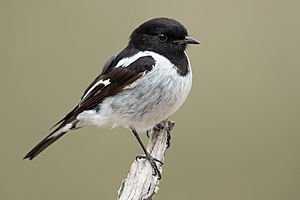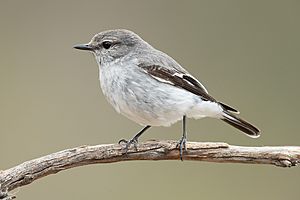Hooded robin facts for kids
Quick facts for kids Hooded robin |
|
|---|---|
 |
|
| male | |
 |
|
| female | |
| Conservation status | |
| Scientific classification | |
| Genus: |
Melanodryas
|
| Species: |
cucullata
|
The hooded robin (Melanodryas cucullata) is a small bird that lives only in Australia. It is a type of passerine bird, which means it's a perching bird.
Like many colorful robins from Australia, the male and female look different. This is called sexual dimorphism. The male has striking black and white feathers. The female is a more plain grey-brown color.
Contents
About the Hooded Robin
The hooded robin is not related to the European robin or the American robin. It belongs to a different group of birds found mostly in Australia and tropical areas. This group includes pardalotes, fairy-wrens, and honeyeaters.
The scientific name Melanodryas cucullata has special meanings. Melanodryas comes from Greek words. Melas means 'black' and dryas means 'wood-nymph'. The word cucullata comes from a Latin word meaning 'hooded'. This name fits the bird's look perfectly!
What Does It Look Like?
The hooded robin is about 16 cm (6 inches) long. That's about the length of a pen!
The male bird has very clear black and white colors. It has a black head and neck, which looks like a "hood." Its chest and belly are white. Its wings are black with white stripes. The male's eyes, beak, and feet are also black.
The female looks quite different. She is mostly grey-brown on her back. Her throat is light grey, and her underside is even paler. Her wings are dark brown with white stripes, just like the male's. Young hooded robins look similar to the females.
Where Do They Live?
You can find hooded robins all over the Australian continent. However, they do not live in Cape York in the far north. They also do not live in Tasmania, an island state.
Their natural home is in areas with Mediterranean-type shrubby plants. This means they like places with bushes and small trees.
Reproduction and Life Cycle
Hooded robins usually breed from July to November. During this time, they might raise one or two groups of babies.
Their nest is a neat, cup-shaped home. It is made from soft, dry grass and pieces of bark. They use Spider webs, feathers, and fur to hold the nest together. Nests are often built in a tree crack, a hollow, or where branches split.
A female hooded robin usually lays two eggs. The eggs are pale olive-green or bluish-green. They have darker spots and blotches. Each egg is about 21 mm long and 16 mm wide.
Protecting the Hooded Robin
The hooded robin is not listed as a threatened species across all of Australia. This is under the national Environment Protection and Biodiversity Conservation Act 1999.
However, their protection status can be different in each Australian state. For example, in the state of Victoria:
- The hooded robin is listed as threatened under the Victorian Flora and Fauna Guarantee Act (1988).
- On a list from 2013, the hooded robin was considered near threatened in Victoria. This means it could become threatened in the future if we are not careful.
See also
 In Spanish: Petroica encapuchada para niños
In Spanish: Petroica encapuchada para niños


